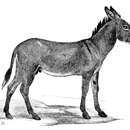en
names in breadcrumbs


The African Wild Ass has a limited range in Eritrea, Ethiopia, Djibouti, and Somalia. This is the ancestor of the domestic donkey. Taxonomic treatments vary, but Rubenstein (2011) treats the African Wild Ass and the domestic donkey as two distinct species, Equus africanus and E. asinus, respectively.
The African Wild Ass inhabits hilly and stony deserts, as well as semi-desert grasslands and euphorbia and aloe shrublands receiving 100 to 200 mm annual rainfall. Sandy habitats are avoided. African Wild Asses have been found up to 1500 m elevation in Ethiopia.
African Wild Asses mainly graze on various grasses. They can lose up to 30% of their body weight in water, then replenish this loss in just a few minutes when water is available. Nevertheless, they must drink every few days and are rarely found more than 30 km from a water source. They live in small groups, typically consisting of fewer than five animals, with mostly short-term associations (except between a mother and her young). The life span is thought to be around 25 to 30 years.
This species is critically endangered and currently occupies only a small portion of its historical range, which once included large stretches of northern Africa. It is threatened by hunting for food and body parts used in traditional healing, competition with livestock for food and water, and possibly interbreeding with domestic donkeys.
(Rubenstein 2011 and references therein)
The African wild ass (Equus asinus) is listed on the IUCN Red List of Threatened Species as Critically Endangered.
Well adapted for the desert life, the African wild ass can only be found in the rocky hills and semi-arid bushlands of northeast Ethiopia, Eritrea and Somalia. Previously its geographic spread also included northern Africa, but due to hunting, numbers have been reduced to as little as 570 individuals.
This ancestor of domestic donkeys resembles a short, stocky horse with long ears on its large head. It has a tufted tail and a stiff, upright mane on the nape of its neck. Its coat is light grey to reddish brown in colour, with a white underbelly and legs, as well as black bands on the legs in the Somalian subspecies. It has long and narrow hooves for a sturdier footing in the rocky desert.
The African wild ass is mainly a grazer of grasses, but eats any type of vegetation, and can go without water for at least three days. They are active during the cooler early mornings and late afternoon, and seek out shade during the hotter parts of the day to rest.
They breed during the wet season and females have a gestation period of one year, giving birth to one foal.
African wild asses are protected by law, but these laws are difficult to enforce and illegal hunting still occur. Research is currently being done to study population size, habitat requirements and threats, in order for better management of this species.
The Nubian wild ass (Equus africanus africanus) is the nominate subspecies of African wild ass, and one of the ancestors of the domestic donkey, which was domesticated about 6,000 years ago.[3][4] It is presumed to be extinct, though two populations potentially survive on the Caribbean island of Bonaire and in Gebel Elba.
According to Groves & Chubb, Nubian wild asses had longer ears than the Somali wild ass, ranging from 182-245mm in length.[5] These animals also possessed the "cross-pattern" famous in domestic donkeys but absent in the Somali subspecies, and lacked the "zebra-stripe-pattern" on the legs as found in Somali specimens.
Nubian wild asses lived in the Nubian Desert of northeastern Sudan, from east of the Nile River to the Red Sea and south to the Atbarah River and northern Eritrea.[1]

The Nubian wild ass has not been seen since the 1950s-70s and is presumed extinct.[6] The last sighting of wild asses in the animal's native range were in the 1970s, in Eritrea's Barka Valley and the border between Eritrea and Sudan, during aerial flights.[1] Similar to the decline of the Somali wild ass, the Nubian wild ass's extinction can largely be attributed to hunting, competition with livestock for limited desert resources, and hybridization with the Domestic donkey.[3]
In 2014–2015, a mitochondrial DNA analysis was conducted on a population of feral donkeys on the Caribbean island of Bonaire. The study included DNA samples from the Bonaire animals, museum specimens of Nubian wild asses, sequences from four Somali wild asses, and a sequence from one Domestic donkey, used as a control. The results found that the Bonaire animals were very close to known pure Nubian wild asses and very different from other asses. However, research published in 2010 found that modern donkeys are descended from two lineages of wild ass, one being Nubian and the other being of unknown ancestry.[7] This being the case, the fact that only one donkey was used in the test suggests that the findings are rather inconclusive. For more conclusive results to be found, more testing must be completed with a larger group of donkeys. Additionally, the analysis was a result of an outcry over the government of Bonaire planning a cull of the feral animals, leading to the possibility of the results being slightly biased towards shutting down the cull.[8]
The Gebel Elba National Park, near the border of Egypt and Sudan, is claimed to be home to a wild population of Nubian wild asses. However, the purity of the animals in question has yet to be studied.
The Nubian wild ass (Equus africanus africanus) is the nominate subspecies of African wild ass, and one of the ancestors of the domestic donkey, which was domesticated about 6,000 years ago. It is presumed to be extinct, though two populations potentially survive on the Caribbean island of Bonaire and in Gebel Elba.